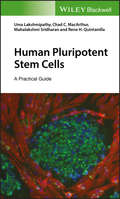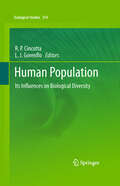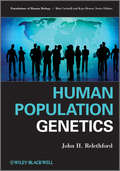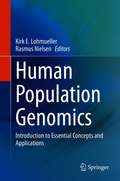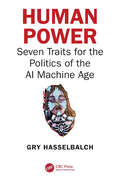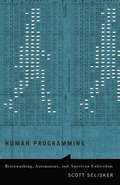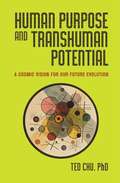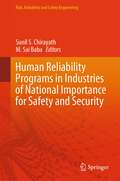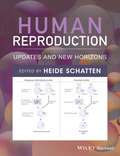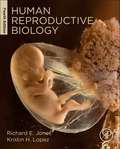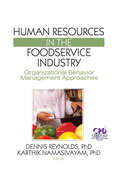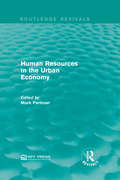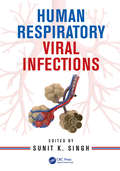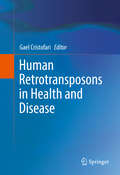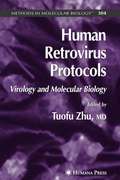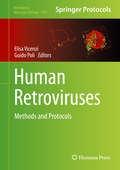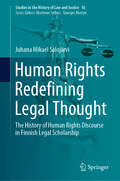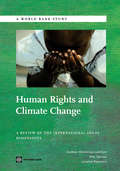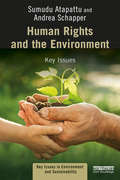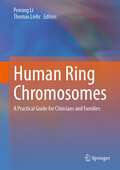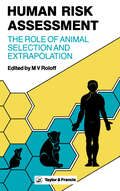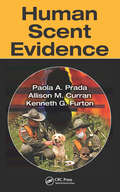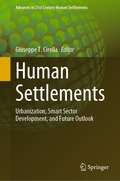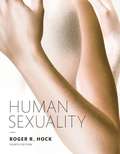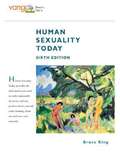- Table View
- List View
Human Pluripotent Stem Cells: A Practical Guide
by Uma Lakshmipathy Chad C. MacArthur Mahalakshmi Sridharan Rene H. QuintanillaComprehensive coverage of the entire induced pluripotent stem cell basic work flow Pluripotent stem cells (PSC) can divide indefinitely, self-renew, and can differentiate to functionally reconstitute almost any cell in the normal developmental pathway, given the right conditions. This comprehensive book, which was developed from a training course, covers all of the PSCs (embryonic, embryonic germ, and embryonic carcinoma) and their functions. It demonstrates the feeder-dependent and feeder-free culture of hESC and hiPSC, which will be referred to in all protocols as PSCs. It also addresses the methods commonly used to determine pluripotency, as defined by self-renewal marker expression and differentiation potential. Human Pluripotent Stem Cells: A Practical Guide offers in-depth chapter coverage of introduction to stem cell, PSC culture, reprogramming, differentiation, PSC characterization, and more. It also includes four appendixes containing information on reagents, medias, and solutions; common antibodies; consumable and equipment; and logs and forms. Includes helpful tips and tricks that are normally omitted from regular research papers Features useful images to support the technical aspects and results visually as well as diagrammatic illustrations Presents specific sections (ie: reprogramming, differentiation) in a concise and easily digestible manner Written by experts with extensive experience in stem cell technologies Human Pluripotent Stem Cells: A Practical Guide is an ideal text for stem cell researchers, including principal investigators, and others in university and industry settings, and for new graduate students in PSC labs.
Human Population
by Richard P. Cincotta Larry J. GorenfloIn this volume the dynamic patterns of human density and distribution are examined in relation to the viability of native species and the integrity of their habitats. Social, biological, and earth scientists describe their models, outline their conclusions from field studies, and review the contributions of other scientists whose work is essential to this field. The book starts with general theories and broad empirical relationships that help explain dramatic changes in the patterns of the occurrence of species, changes that have developed in parallel with human population growth, migration and settlement. In the following chapters specific biomes and ecosystems are highlighted as the context for human interactions with other species. A discussion of the key themes and findings covered rounds out the volume. All in all, the work presents our species, Homo sapiens, as what we truly have been and will likely remain--an influential, and often the most influential, constituent in nearly every major ecosystem on Earth.
Human Population Genetics (Foundation of Human Biology #7)
by John H. RelethfordIntroductory guide to human population genetics and microevolutionary theory Providing an introduction to mathematical population genetics, Human Population Genetics gives basic background on the mechanisms of human microevolution. This text combines mathematics, biology, and anthropology and is best suited for advanced undergraduate and graduate study. Thorough and accessible, Human Population Genetics presents concepts and methods of population genetics specific to human population study, utilizing uncomplicated mathematics like high school algebra and basic concepts of probability to explain theories central to the field. By describing changes in the frequency of genetic variants from one generation to the next, this book hones in on the mathematical basis of evolutionary theory. Human Population Genetics includes: Helpful formulae for learning ease Graphs and analogies that make basic points and relate the evolutionary process to mathematical ideas Glossary terms marked in boldface within the book the first time they appear In-text citations that act as reference points for further research Exemplary case studies Topics such as Hardy-Weinberg equilibrium, inbreeding, mutation, genetic drift, natural selection, and gene flow Human Population Genetics solidifies knowledge learned in introductory biological anthropology or biology courses and makes it applicable to genetic study. NOTE: errata for the first edition can be found at the author's website: http://employees.oneonta.edu/relethjh/HPG/errata.pdf
Human Population Genomics: Introduction to Essential Concepts and Applications
by Rasmus Nielsen Kirk E. LohmuellerThis textbook provides a concise introduction and useful overview of the field of human population genomics, making the highly technical and contemporary aspects more accessible to students and researchers from various fields. Over the past decade, there has been a deluge of genetic variation data from the entire genome of individuals from many populations. These data have allowed an unprecedented look at human history and how natural selection has impacted humans during this journey. Simultaneously, there have been increased efforts to determine how genetic variation affects complex traits in humans. Due to technological and methodological advances, progress has been made at determining the architecture of complex traits. Split in three parts, the book starts with the basics, followed by more advanced and current research. The first part provides an introduction to essential concepts in population genetics, which are relevant for any organism. The second part covers the genetics of complex traits in humans. The third part focuses on applying these techniques and concepts to genetic variation data to learn about demographic history and natural selection in humans. This new textbook aims to serve as a gateway to modern human population genetics research for those new to the field. It provides an indispensable resource for students, researchers and practitioners from disparate areas of expertise.
Human Power: Seven Traits for the Politics of the AI Machine Age
by Gry HasselbalchThe rapid and tumultuous technological transformation of our societies has triggered a self-exploratory public debate about what it means to be human. What are our human potential, talents, and powers – what, essentially, is our place in the modern world? Will a culture of machines out-compete a culture of humanity?In this thought-provoking but ultimately hopeful book, scholar and leading technology critic Gry Hasselbalch invites readers to reflect on the shifting dynamics between humans and the AI-powered technologies increasingly shaping our world. Exploring the distinctiveness of human power, the book addresses current debates about technology that portray humans as powerless and flawed – in essence outdated software in dire need of a technological fix – arguing that human power must remain central in discussions about AI and technology. It investigates seven key traits which set humans apart from machines: Creativity, Intuition, Emotion, Life, Defiance, Love, and Wisdom. Drawing on interviews and examples from across arts – including literature, visual arts, film and music – and from technology politics and policymaking, Human Power explains how these traits provide a foundation for a new politics in the AI Machine Age. One that does not diminish and reduce human power, but actively protects and reinforces it.If human power is not a computational process, then what is it? Human Power: Seven Traits for the Politics of the AI Machine Age gives human power – our humanity and fundamental “humanness” – a renewed voice in a debate dominated by fears and preconceptions about technological power. This important new work will appeal to journalists, policymakers, artists, and educators—and anyone else interested in the rapidly growing role of AI and digital technology in our lives.
Human Programming: Brainwashing, Automatons, and American Unfreedom
by Scott SeliskerDo our ways of talking about contemporary terrorism have a history in the science, technology, and culture of the Cold War? Human Programming explores this history in a groundbreaking work that draws connections across decades and throughout American culture, high and low. Scott Selisker argues that literary, cinematic, and scientific representations of the programmed mind have long shaped conversations in U.S. political culture about freedom and unfreedom, and about democracy and its enemies. Selisker demonstrates how American conceptions of freedom and of humanity have changed in tandem with developments in science and technology, including media technology, cybernetics, behaviorist psychology, and sociology. Since World War II, propagandists, scientists, and creative artists have adapted visions of human programmability as they sought to imagine the psychological manipulation and institutional controls that could produce the inscrutable subjects of totalitarian states, cults, and terrorist cells. At the same time, writers across the political spectrum reimagined ideals of American freedom, democracy, and diversity by way of contrast with these posthuman specters of mental unfreedom. Images of such &“human automatons&” circulated in popular films, trials, travelogues, and the news media, giving form to the nebulous enemies of the postwar and contemporary United States: totalitarianism, communism, total institutions, cult extremism, and fundamentalist terrorism. Ranging from discussions of The Manchurian Candidate and cyberpunk science fiction to the cases of Patty Hearst and the &“American Taliban&” John Walker Lindh, Human Programming opens new ways of understanding the intertwined roles of literature, film, science, and technology in American culture.
Human Purpose and Transhuman Potential: A Cosmic Vision for Our Future Evolution
by Ted Chu[from inside flaps] ""Today we stand at a new frontier. We have within our sight--if not yet within our reach--a radically new human freedom. It is the freedom from our inborn genetic condition--the liberation from the constraints of our biological form.... The human era as we have known it is coming to an end. The posthuman era is about to begin." So writes Ted Chu, in this magisterial treatment of the increasingly timely debate about transhumanism and the meaning and purpose of human evolution. A prominent macroeconomist and polymath, Chu offers the most systematic effort yet to explore the scientific, historical, ethical, and philosophical dimensions of this worldwide discussion, reframing a field too often disfigured by scientific reductionism. Chu immediately establishes an interdisciplinary and evolutionary stance and then examines the ongoing transhumanist project from a rich variety of perspectives. He goes on to articulate a goal for humanity in the face of technological breakthroughs that beckon us toward previously unimagined potentials for progress--that is, if we can find the courage to consciously manage our own evolution. A new understanding of transhumanism emerges as he plumbs the depths of the world's wisdom traditions and surveys the most cutting-edge evolutionary theories and scientific advances. While admitting that the pursuit of human happiness is appropriate and noble, Chu demonstrates why our ultimate purpose--our "new divine covenant"--is to serve the forward march of cosmic evolution through the transcendence of our own biology, thus making way for our evolutionary successors in the posthuman future."
Human Reliability Programs in Industries of National Importance for Safety and Security (Risk, Reliability and Safety Engineering)
by Sunil S. Chirayath M. Sai BabaThis book discusses human reliability programs (HRPs) and their various elements, including safety and security case studies. The topics covered include significance and vulnerability aspects of human reliability and sustainable HRP, including case studies and lessons learned, methodologies used for human reliability analysis, and good practices of HRPs from various industries. Human reliability is widely used in fields requiring high standards of safety, such as the aviation, petroleum and chemical process, and nuclear industries. The book showcases contributions on the topic from experts in the field of technology, design, aviation, and nuclear industries. The book can be a valuable reference for researchers and professionals interested in HRP to ensure safety and security in industries.
Human Reproduction: Updates and New Horizons
by Heide SchattenIn vitro fertilization (IVF) and other assisted reproductive technologies (ART) have become a significant part of human reproduction, with already one in 50 children worldwide being born through ART and the demand steadily increasing. To accommodate the various kinds of infertility problems, new methods have been developed to increase IVF and ART success rates and it has also become possible to treat sperm, eggs, and embryos in culture to improve reproductive success, to increase the health state of an embryo, and to prevent disease in the developing child. Human Reproduction: Updates and New Horizons focuses on recent developments and new approaches to study egg and sperm cells and embryo development, as well as addressing the increasing demand for IVF and ART to overcome infertility problems of various kinds that are encountered by an increasing number of couples worldwide. The book includes 10 chapters written by experts in their specific fields to provide information on sperm selection techniques and their relevance to ART; In vitro maturation of human oocytes: current practices and future promises; Molecular biology of endometriosis; Novel immunological aspects for the treatment of age-induced ovarian and testicular infertility, other functional diseases, and early and advanced cancer immunotherapy; Mitochondrial manipulation for infertility treatment and disease prevention; Novel imaging techniques to assess gametes and preimplantation embryos; Clinical application of methods to select in vitro fertilized embryos; New horizons/developments in time-lapse morphokinetic analysis of mammalian embryos; The non-human primate model for early human development; Cytoskeletal functions, defects, and dysfunctions affecting human fertilization and embryo development. This book will appeal to a large interdisciplinary audience, including researchers from both the basic science and medical communities. It will be a valuable reference for IVF clinicians, patients and prospective patients who are considering ART procedures, embryologists, cell biologists and students in the field of reproduction.
Human Reproductive Biology, 4th Edition
by Kristin H. Lopez Richard E. JonesThe fourth edition of Human Reproductive Biology-winner of a 2015 Textbook Excellence Award (Texty) from The Text and Academic Authors Association-emphasizes the biological and biomedical aspects of human reproduction, explains advances in reproductive science and discusses the choices and concerns of today. Generously illustrated in full color, the text provides current information about human reproductive anatomy and physiology. This expansive text covers the full range of topics in human reproduction, from the biology of male and female systems to conception, pregnancy, labor and birth. It goes on to cover issues in fertility and its control, population growth and family planning, induced abortion and sexually transmitted diseases. This is the ideal book for courses on human reproductive biology, with chapter introductions, sidebars on related topics, chapter summaries and suggestions for further reading. Winner of a 2015 Texty Award from the Text and Academic Authors Association Beautifully redrawn full-color illustrations complement completely updated material with the latest research results, and clear, logical presentation of topics Covers the basic science of reproduction-endocrinology, anatomy, physiology, development, function and senescence of the reproductive system-as well as applied aspects including contraception, infertility and diseases of the reproductive system New companion website features full-color illustrations as PPT and jpeg files for both professors and students to use for study and presentations
Human Resources in the Foodservice Industry: Organizational Behavior Management Approaches
by Dennis Reynolds Karthikeyan NamasivayamGet up-to-date research and innovative management strategiesOrganizational behavior and human resource management are fundamental aspects in the profitability of any foodservice business. Human Resources in the Foodservice Industry: Organizational Behavior Management Approaches examines the latest research critical in understanding indi
Human Resources in the Urban Economy (Routledge Revivals)
by Mark PerlmanDue to the urbanisation of American society and the economic problems that accompanied it; a series of conferences was held to explore the economics of human resources. Originally published in 1963, this study draws together papers from the first conference dealing mainly with the under-utilisation and misallocation of human resources, as well as wage rates, migration patterns and education in urban societies and the impact they have on the American labour force. This title will be of interest to students of Environmental Studies and Economics.
Human Respiratory Viral Infections
by Sunit SingUsing a multidisciplinary approach, Human Respiratory Viral Infections is set at the level between the definitive reference work and an essential clinical manual. Exploring recent advances in human respiratory viral research, the text builds on the basic sciences of epidemiology, virology, molecular biology, and immunology to cover clinical diagnosis, mechanism of pathogenesis, manifestations of disease, impact, treatment, and management strategies. <P><P> <li>Provides a comprehensive review of all the major human respiratory viral infections <li>Supplies a detailed description of the anatomy of the respiratory system <li>Discusses the salient features of specific viruses <li>Examines the latest diagnostic tools <li>Covers risk factors associated with incidence of respiratory viral infections in children and adults in different occupational and environmental settings <P><P>Presenting the latest knowledge in human respiratory viral infections, this text will be immensely valuable for pulmonologists, biomedical scientists, research scholars, virologists, vaccinologists, immunologists, clinicians, pharmacologists, and public health specialists.
Human Retrotransposons in Health and Disease
by Gael CristofariThis unique book explores the role of retrotransposons in human health and disease. The ability of retrotransposons to affect the structure of human genes is recognized since the late 80's. However, the advances of deep-sequencing technologies have shed new light on the extent of retrotransposon-mediated genome variations. These progresses have also led to the discovery that retrotransposon activity is not restricted to the germline - resulting in inheritable genetic variations - but can also mobilize in somatic tissues, such as embryonic stem cells, neuronal progenitor cells, or in many cancers. This book covers topics related to the effects of retrotransposon insertions, and their consequences on germline and somatic genome dynamics, but also discuss the role and impact of retrotransposons sequences in a broader context, including a number of novel topics that emerged recently (long non-coding RNA, neuronal disorders, exaptation) with unexpected connections between retrotransposons, stem cell maintenance, placentation, circadian cycles or aging.
Human Retrovirus Protocols
by Tuofu ZhuA cutting-edge collection of basic and state-of-the-art methods optimized for investigating the molecular biology of this class of retrovirus. These readily reproducible techniques range from methods for the isolation and detection of human retroviruses to cutting-edge methods for exploring the interplay between the viruses and the host. Here, the researcher will find up-to-date techniques for the isolation and propagation of HIV, HTLV, and foamy virus from a variety of sources. There are also assays for determining the cell tropism of HIV-1, the coreceptor usage of HIV-1, and human gene expression with HIV-1 infection by microarrays, as well as for phenotyping HIV-1 infected monocytes and examining their fitness. Highlights include the detection and quantification of HIV-1 in resting CD4+, a new cloning system for making recombinent virus, cDNA microarrays, and the determination of genetic polymorphisms in two recently identified HIV-1 co-factors that are critical for HIV-1 infection.
Human Retroviruses
by Elisa Vicenzi Guido Poli"Human Retroviruses: Methods and Protocols" collects key experimental protocols that have provided the basis of the major discoveries of the field. Split into five sections, this detailed volume covers mapping of the HIV life cycle, isolation, co-receptor use, and cell tropism of HIV-1, in vivo quantification of HIV-1, biological aspects of HIV-1, as well as HTLVs. Some articles explore assay and function of accessory genes, largely involving the interface between retroviral and host factors, the extracellular role of Tat and Tax, resembling the function of cytokines, and the biotechnological exploitation of HIV as lentiviral vector to carry foreign genes with therapeutic value. Written in the highly successful "Methods in Molecular Biology" series format, chapters include introductions to their respective topics, lists of the necessary materials and reagents, step-by-step, readily reproducible laboratory protocols, and tips on troubleshooting and avoiding known pitfalls. Comprehensive and authoritative, "Human Retroviruses: Methods and Protocols" provides state-of-art methodological protocols from world leaders in human retrovirology, essential for any lab working this vital field. "
Human Rights Redefining Legal Thought: The History of Human Rights Discourse in Finnish Legal Scholarship (Studies in the History of Law and Justice #16)
by Juhana Mikael SalojärviThis book investigates the origins and development of human rights discourse in Finnish legal scholarship in the twentieth century. It provides a detailed account of how human rights were understood before they had legal relevance in a positivist sense, how they were adapted to Finnish legal thinking in the post-Second World War decades, how they developed into a mode of legal rhetoric and a type of legal argument during the 1970s and 1980s, and how they eventually became a significant paradigm in legal thinking in the 1990s. The book also demonstrates how rights discourse infiltrated the discussion regarding problems that were previously addressed in arguments concerning morals, social justice and equity. Although the book focuses on the history of Finnish legal scholarship, it is also interesting from a global perspective for two reasons: Firstly, it demonstrates how an idea of international law is transplanted and diffused into national legal thinking; Finland is an illustrative example in this regard. Secondly, it offers insights into the general history of human rights.
Human Rights and Climate Change
by Siobhan Mcinerney-Lankford Mac Darrow Lavanya RajamaniThis Study explores arguments about the impact of climate change on human rights, examining the international legal frameworks governing human rights and climate change and identifying the relevant synergies and tensions between them. It considers arguments about (i) the human rights impacts of climate change at a macro level and how these impacts are spread disparately across countries; (ii) how climate change impacts human rights enjoyment within states and the equity and discrimination dimensions of those disparate impacts; and (iii) the role of international legal frameworks and mechanisms, including human rights instruments, particularly in the context of supporting developing countries' adaptation efforts. The Study surveys the interface of human rights and climate change from the perspective of public international law. It builds upon the work that has been carried out on this interface by reviewing the legal issues it raises and complementing existing analyses by providing a comprehensive legal overview of the area and a focus on obligations upon States and other actors connected with climate change. The objective has therefore been to contribute to the global debate on climate change and human rights by offering a review of the legal dimensions of this interface as well as a survey of the sources of public international law potentially relevant to climate change and human rights in order to facilitate an understanding of what is meant, in legal terms, by "human rights impacts of climate change" and help identify ways in which international law can respond to this interaction. This is a complex and dynamically evolving legal and policy landscape and this study aims to capture its most salient features insofar as they appear at present. The Study employs the following three-part conceptual understanding of the links between human rights and climate change. First, climate change may affect the enjoyment of human rights: this is explored in part II and draws from the existing work of the United Nations (UN) Office of the High Commissioner for Human Rights (OHCHR), the UN Human Rights Council and the International Council on Human Rights Policy. Second, measures to address climate change may impact the realization of human rights. This is a subset of the discussion of "impacts" targeting "secondary" human rights impacts of measures aimed at addressing climate change. Third, human rights have relevance to policy and operational responses to climate change, such that human rights obligations (both substantive and procedural) may be relevant to the design and implementation of effective responses to climate change, particularly in relation to adaptation and to some extent also to mitigation. Human rights may also have a role in promoting resilience to climate change and may reinforce sustainable development goals. The Study includes a number of approaches from connecting climate change to specific human rights impacts under international human rights law, to tracing the applicable sources of law and surveying identifiable obligations under international human rights law and international environmental law. The Study reviews how human rights law addresses environmental protection in substantive and procedural terms focusing in particular on the advances made in the latter through the jurisprudence of regional human rights bodies for example. The Study considers also how environmental protection has been extended to regulate private as well as public action. Following from this is a discussion of the application of human rights to climate change, including an outline of the various ways in which human rights can be seen to "add value" to the discourse, including the use of human rights legal framework as a tool for helping analyse climate impacts and determining appropriate policy responses. The Study includes a summary analysis of principles and precepts of international human rights law and multilateral environmental agreements (MEA) to consider their compatibility in conceptual terms. It concludes wi...
Human Rights and the Environment: Key Issues (Key Issues in Environment and Sustainability)
by Sumudu Atapattu Andrea SchapperThe field of human rights and the environment has grown phenomenally during the last few years and this textbook will be one of the first to encourage students to think critically about how many environmental issues lead to a violation of existing rights. Taking a socio-legal approach, this book will provide a good understanding of both human rights and environmental issues, as well as the limitations of each regime, and will explore the ways in which human rights law and institutions can be used to obtain relief for the victims of environmental degradation or of adverse effects of environmental policies. In addition, it will place an emphasis on climate change and climate policies to highlight the pros and cons of using a human rights framework and to underscore its importance in the context of climate change. As well as identifying emerging issues and areas for further research, each chapter will be rich in pedagogical features, including web links to further research and discussion questions for beyond the classroom. Combining their specialisms in law and politics, Atapattu and Schapper have developed a truly inter-disciplinary resource that will be essential for students of human rights, environmental studies, international law, international relations, politics, and philosophy.
Human Ring Chromosomes: A Practical Guide for Clinicians and Families
by Thomas Liehr Peining LiThis book presents chromosome-wise clinical cases following an evidence-based protocol, in addition to providing the scientific background on the mechanisms of human ring chromosome (RC) formation. Presence of RCs in a genome can lead to several rare genetic diseases. This book, edited by the leading experts Prof. Peining Li and Prof. Thomas Liehr, is the first comprehensive book on this topic.Over the past 60 years, banding cytogenetics, fluorescence in situ hybridization, chromosome microarray analysis, and whole genome sequencing have been used to diagnose cases with a RC. Ring syndrome of sever growth retardation and variable intellectual disability has been considered a common clinical feature for all RCs. Clinical heterogeneity of chromosome-specific deletion and duplication syndromes, gene-related organ and tissue defects, cancer predisposition to different types of tumors, and reproduction failure has been reported in the literature. However, the cases of RCs reportedin the literature account for less than 1% of its real occurrence. Current diagnostic practice lacks laboratory standards for analyzing cellular behavior and genomic imbalances of RCs to evaluate its compound effects on patients. The under-representation of clinical cases and the lack of comprehensive diagnostic analysis make challenging to establish accurate clinico-cytogenomic correlations. Given recent advances in genomic technology and organized efforts from peer experts, standardized cytogenomic diagnosis and evidence-based clinical management could be envisioned for all patients with RCs.Furthermore, supernumerary small ring chromosomes and the patient’s perspective are addressed—the latter by including family stories of RC-carrier relatives. Acquired RCs in various cancers are also discussed, as well as the potential role of RCs in research applications like iPSC cellular modeling and genomic editing.This book is a valuable reference for clinical geneticists, personnel in cytogenetics and molecular genetics laboratories, genetic counselors, and researchers in related fields.
Human Risk Assessment: The Role Of Animal Selection And Extrapolation
by M. V. Roloff; A. G. E. Wilson; W. E. Ribelin; W. P. Ridley; F. A. RueckerThis book explores the factors which are critical in the selection of an appropriate animal species for toxicology studies and the subsequent extrapolation of the data to humans. It provides some future directions for risk assessment activities at the Environmental Protection Agency.
Human Scent Evidence (Forensic Science Techniques Ser.)
by Paola A. Prada Allison M. Curran Kenneth G. FurtonDuring the last decade, scientific studies have supported using human scent as a biometric tool and indicator of the presence or absence of an individual at a crime scene. This book focuses on some of these recent advances in the use of human scent as forensic evidence. It examines theories of human odor production, the legal significance of results, and canine scent work from multiple search categories as described in the Scientific Working Group on Dog and Orthogonal detector Guidelines (SWGDOG). It also explores current trends in scent collection techniques, including devices, materials, and storage protocols.
Human Settlements: Urbanization, Smart Sector Development, and Future Outlook (Advances in 21st Century Human Settlements)
by Giuseppe T. CirellaThe answers to the questions of why and how people live where they live as well as how they maintain and integrate with one another are fundamental human settlement issues rooted in history and culture. Human settlements are historically linked to resource availability, fortification, and the mythos of civilizations. Cities play a central role in redefining the interface between human beings and nature. They have revolutionized the human experience by taming natural surroundings and building environments that are human-centric—often narrowing human life outside the experience of wilderness or the untamed. This book is divided into three parts, it examines urban development trends, explores perspectives in energy efficiency and agriculture security, and considers policy development and future scenarios in human-nature relations. It is a compendium of multidisciplinary work that challenges the directions of modernity and offers reference to alternatives. Authors come from a diverse background and international context to address common overarching theories facing current geography-specific problems. An interconnected overtone of the book attempts to link accelerated urbanization and settlement location to how societies are maintained and integrated. Human settlements are shaped by human ecology and the relationship between humans and their interaction with their environment. Two sectors central to human survival are specifically explored: energy and agriculture. Cutting-edge, smart development looks at the latest findings that reflect the on-going debate facing these sectors. A human settlement metric is envisioned in terms of the past, present, and future. This book is a unique attempt to combine a rethinking about human settlements for scientists, policy-makers, public officials, and people committed to improving urban life, society-wide. Possible agents to resolving human settlement problems include international cooperation and various mechanisms that interlace the international community. Methodological and applied aspects of sustainable management focus on topics such as adaptive knowledge sharing, renewable energy, climate change, agricultural planning, and policy development. An emphasis on scientific and technological advancement, from a bottom-up mapping of society, elucidates a better understanding of the role of knowledgeable societies in which need is considered alongside how such need can be sustained—advancing towards a more promising future.
Human Sexuality
by Roger R. HockHelp each student develop a sexual philosophy based on choice, awareness, and responsibility Human Sexuality presents a relatable overview of the discipline that inspires students to think critically about the sexual world and their place in it. By taking an interpersonal approach and encouraging each student to develop a personal sexual philosophy, author Roger Hock helps students connect the material covered to their real-life decisions and behaviors, boosting engagement with the course. Sensitivity to diverse groups – not only in terms of race and ethnicity, but also in terms of sexual orientation, age, sexual knowledge, and sexual experience – allows all students to feel as comfortable and open about sexual topics as possible. The Fourth Edition includes updated data as well as coverage of contemporary issues that dominate today's headlines to ensure currency and relevancy.
Human Sexuality Today (6th Edition)
by Bruce M. KingThe sixth edition of Human Sexuality Today provides students with the information they need to make responsible decisions and helps them feel comfortable about themselves while learning about their sexuality.
